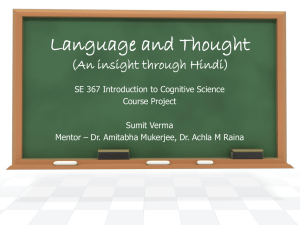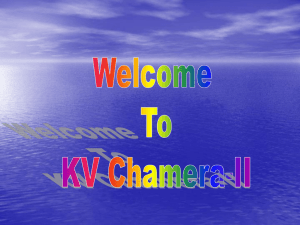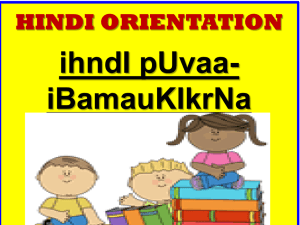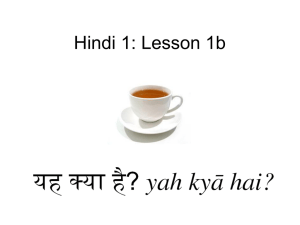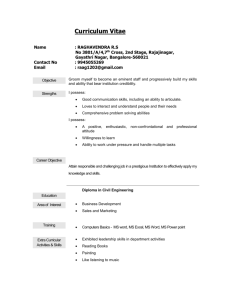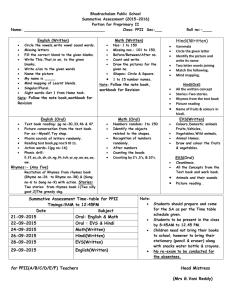University of Kent at Canterbury
advertisement
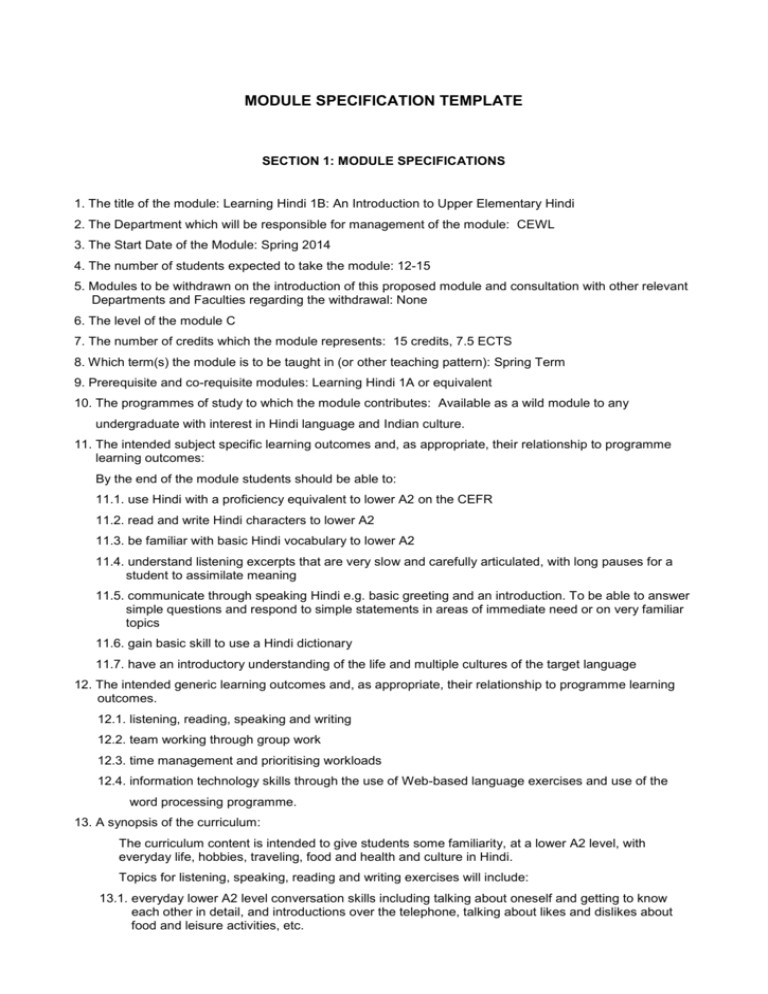
MODULE SPECIFICATION TEMPLATE SECTION 1: MODULE SPECIFICATIONS 1. The title of the module: Learning Hindi 1B: An Introduction to Upper Elementary Hindi 2. The Department which will be responsible for management of the module: CEWL 3. The Start Date of the Module: Spring 2014 4. The number of students expected to take the module: 12-15 5. Modules to be withdrawn on the introduction of this proposed module and consultation with other relevant Departments and Faculties regarding the withdrawal: None 6. The level of the module C 7. The number of credits which the module represents: 15 credits, 7.5 ECTS 8. Which term(s) the module is to be taught in (or other teaching pattern): Spring Term 9. Prerequisite and co-requisite modules: Learning Hindi 1A or equivalent 10. The programmes of study to which the module contributes: Available as a wild module to any undergraduate with interest in Hindi language and Indian culture. 11. The intended subject specific learning outcomes and, as appropriate, their relationship to programme learning outcomes: By the end of the module students should be able to: 11.1. use Hindi with a proficiency equivalent to lower A2 on the CEFR 11.2. read and write Hindi characters to lower A2 11.3. be familiar with basic Hindi vocabulary to lower A2 11.4. understand listening excerpts that are very slow and carefully articulated, with long pauses for a student to assimilate meaning 11.5. communicate through speaking Hindi e.g. basic greeting and an introduction. To be able to answer simple questions and respond to simple statements in areas of immediate need or on very familiar topics 11.6. gain basic skill to use a Hindi dictionary 11.7. have an introductory understanding of the life and multiple cultures of the target language 12. The intended generic learning outcomes and, as appropriate, their relationship to programme learning outcomes. 12.1. listening, reading, speaking and writing 12.2. team working through group work 12.3. time management and prioritising workloads 12.4. information technology skills through the use of Web-based language exercises and use of the word processing programme. 13. A synopsis of the curriculum: The curriculum content is intended to give students some familiarity, at a lower A2 level, with everyday life, hobbies, traveling, food and health and culture in Hindi. Topics for listening, speaking, reading and writing exercises will include: 13.1. everyday lower A2 level conversation skills including talking about oneself and getting to know each other in detail, and introductions over the telephone, talking about likes and dislikes about food and leisure activities, etc. 13.2. lower A2 level skills useful to people visiting living in India including making enquiries, asking for help and directions in a town or city, ordering food in a restaurant, describing travel experiences, etc. 13.3. topics related at lower A2 level to Hindi culture, festivals, history, geography and the arts including major cities, famous places, literature, museums, etc. 13.4. The translation from Hindi to English and vice versa of lower A2 level vocabulary and sentences will be included. There will be a balance between communicative activities, and understanding of vocabulary and grammatical structure. 14. Indicative Reading List: Core-textbooks: Hindi: Beginner's Course (World Language), by Living Language, Publisher: Living Language,U.S.; Com/Pap edition, 28 Dec 2007, ISBN-13: 978-1400023455 Reference Books: Elementary Hindi, by Richard Delacy and Sudha Joshi, Tuttle Publishing; Har/MP3 Bl edition (10 Jan 2009) Get Started in Hindi (2nd Ed.) by Snell, R., Publisher: Teach Yourself, (2010) Teach yourself beginner’s Hindi script by Rupert Snell, Publisher: Teach Yourself Hindi An Essential Grammar by Rama Kant Agnihotri, Publisher: Routledge; New Ed edition (21 May 2007) The Oxford Hindi-English Dictionary by R. S. McGregor, Publisher: OUP Oxford; New Ed edition (27 Feb 1997) Online rescource: http://taj.chass.ncsu.edu/ Multimedia interactive elementary Hindi learning website prepared by the International Research and Studies Programme of the US Department of Education. 15. Learning and Teaching Methods, including the nature and number of contact hours and the total study hours that will be expected of students, and how these relate to achievement of the intended learning outcomes Learning and Teaching Methods: Three contact hours per week. 30 teaching hours and 9.5 hours per week self- study hours.150 total study hours. Classes will be small to allow for close involvement and interaction. A combination of individual, pair and group work will develop speaking, reading, listening and writing skills. Achievement of learning outcomes: Lessons in class and self-study will address 11.1-11.7 and 12.1. Working in pairs and groups in class will develop 12.2. Preparation and revision for the lessons and the assessments will develop 12.3. The use of Web-based language exercises will address 12.4 16. Assessment methods and how these relate to testing achievement of the intended learning outcomes: 100 % coursework: Assessment 1 In-Class-Test 30%: LO11 (11.1)(11.2)(11.3)(11.4) LO12 (12.1) (12.3) Reading, writing and Listening 1 hour Oral: 20%: LO11(11.5)(12.1)(12.3) 3-4 minutes week 18 week 22 Topic will be selected from the curriculum area. Student talks for 1-2 minutes followed with conversation with examiner on the topic Assessment 2 In-Class-Test 50%: LO11 (11.1)(11.2)11.3)(11.4) LO12 (12.1) (12.3) Reading, writing and Listening 1.5 hours week 24 17. Implications for learning resources, including staff, library, IT and space. A part-time member of staff will teach this module. There will be one class per group of 15 students. 18. The School recognises and has embedded the expectations of current disability equality legislation, and supports students with a declared disability or special educational need in its teaching. Within this module we will make reasonable adjustments wherever necessary, including additional or substitute materials, teaching modes or assessment methods for students who have declared and discussed their learning support needs. Arrangements for students with declared disabilities will be made on an individual basis, in consultation with the University’s disability/dyslexia support service, and specialist support will be provided where needed. SECTION 2: MODULE IS PART OF A PROGRAMME OF STUDY IN A UNIVERSITY SCHOOL Statement by the School Director of Learning and Teaching/School Director of Graduate Studies (as appropriate): "I confirm I have been consulted on the above module proposal and have given advice on the correct procedures and required content of module proposals" ................................................................ .............................................. Director of Learning and Teaching/Director of Graduate Studies (delete as applicable) Date ………………………………………………… Print Name Statement by the Head of School: "I confirm that the School has approved the introduction of the module and, where the module is proposed by School staff, will be responsible for its resourcing" ................................................................. .............................................. Head of School Date ……………………………………………………. Print Name

